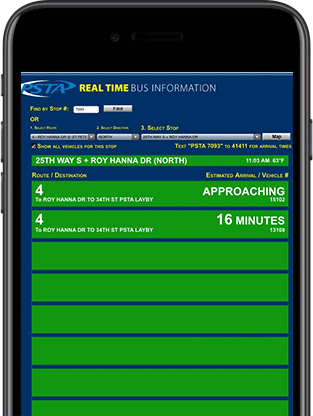Earlier this year, we talked all about the first steps PSTA takes when launching a new service in Deep Drive: How We Launch New Services (Part 1). We covered everything from where ideas come from to ironing out the details to finding the funding to execute them. Now, we’ll dive into the ways we schedule the service, train our staff, reach out to the public, brand the service, and plan the launch event!
Building the Schedule
With funding secured and a stamp of approval from PSTA’s Board of Directors, it’s time to actually schedule the service. That’s where PSTA’s Scheduling team steps in. Working in concert with the Planning team, PSTA’s Schedulers use a number of transit programs to help them create the route, build the individual trips, determine the number of vehicles required, and plan how the vehicles will block together.
First, the team plans the service in a program called Remix, a map-based software saturated with vital demographic and geographic data to create a better understanding of who the service will benefit. This visual, intuitive tool is essential for ironing out the fine details Scheduling needs to generate the robust timetables and spans of service you see in schedules today.
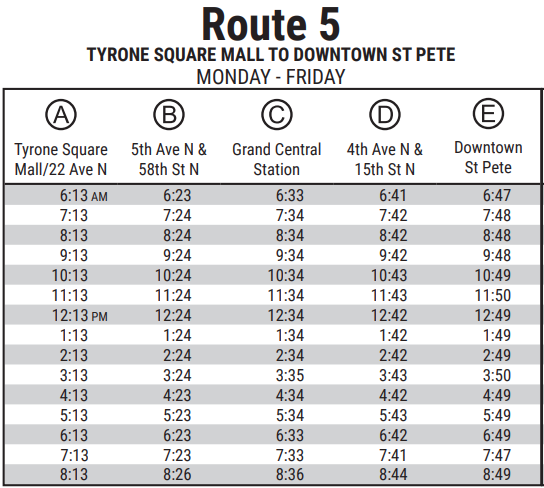
An example of a timetable from the Route 5 schedule.
Another important program Scheduling uses, Hastus, allows the team to build those aforementioned timetables and vehicle schedules, as well as assisting with budgeting, contracting hours, and the miles anticipated. However, even with the assistance of these two programs, this work is extremely time-intensive.
“I can easily work 60-hour weeks trying to get everything done,” PSTA’s Manager of Scheduling Christine said. “But it doesn’t feel like work. This is what we love to do.”
Once the roster is ready for export, it’s inputted into PSTA’s Computer-Aided Dispatch (CAD) and Automatic Vehicle Location (AVL) system, Clever, as well as the agency’s other legacy systems. When this process is finally complete, the information is passed off to the Marketing, Outreach, and Safety, Security, & Training teams to begin their work.
Training Begins
Safety, Security, & Training (SS&T) play a very important role when it comes to new services—ensuring what’s on paper is feasible on the street. No one knows Pinellas County streets like our SS&T team. With turn-by-turn routes in hand, the SS&T team hits the road to make sure vehicles can safely make their turns without impeding traffic or endangering the safety of other cars and pedestrians. With any needed tweaks made and the blessings of SS&T, the next step is to train the operators.
The team will teach bus operators how the new service will work, where it will operate, and provide turn-by-turn directions to follow. Operators who are unfamiliar with the routing are encouraged to drive the route in their personal cars to get accustomed to the turns, landmarks, and things to look out for.
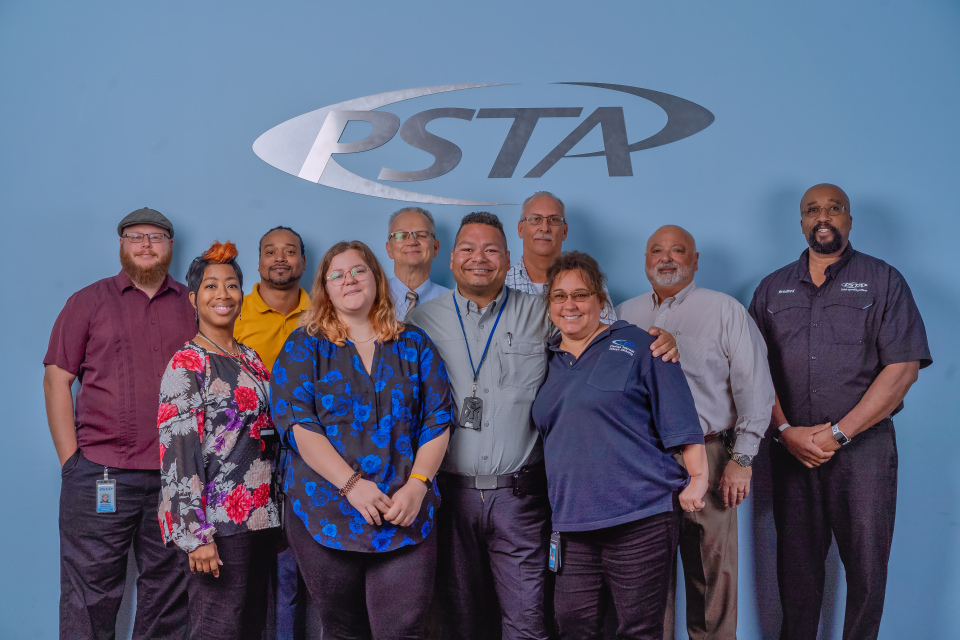
PSTA's Operations team, including Safety, Security, & Training.
When launch day finally arrives, it’s all hands on deck for SS&T, as well as for the Transportation Supervisors. Many of these folks will be patrolling out in the field to help with any issues. Should any wrong turns occur, there is plenty of support to help operators get quickly back on track. Hey, who hasn’t made the occasional wrong turn?
Even after the launch of the service, feedback and improvements remain ongoing.
“My most sacred task is to take stories and anecdotes from the operators and turn them into change. Things like, ‘Hey, this turn is too tight.’” Not everyone has the same experience, so it’s important we hear from everyone,” Safety, Security & Training Supervisor Eddie Kester said.
Branding
So, the service now exists in PSTA’s internal systems, and staff have been trained on how it will operate. But how will anyone use the service if they don’t even know its name? That’s where the Marketing department comes in.
Once a new service is greenlit, Marketing will begin working on concepts, moodboards, color swatches, and lists of brand names, even before Scheduling completes their work! Over the course of months or weeks, the Marketing department will whittle their big ideas down into a cohesive, exciting brand treatment. Sometimes, Marketing will also employ the talents of artists outside of the agency, like in the case of SunRunner.
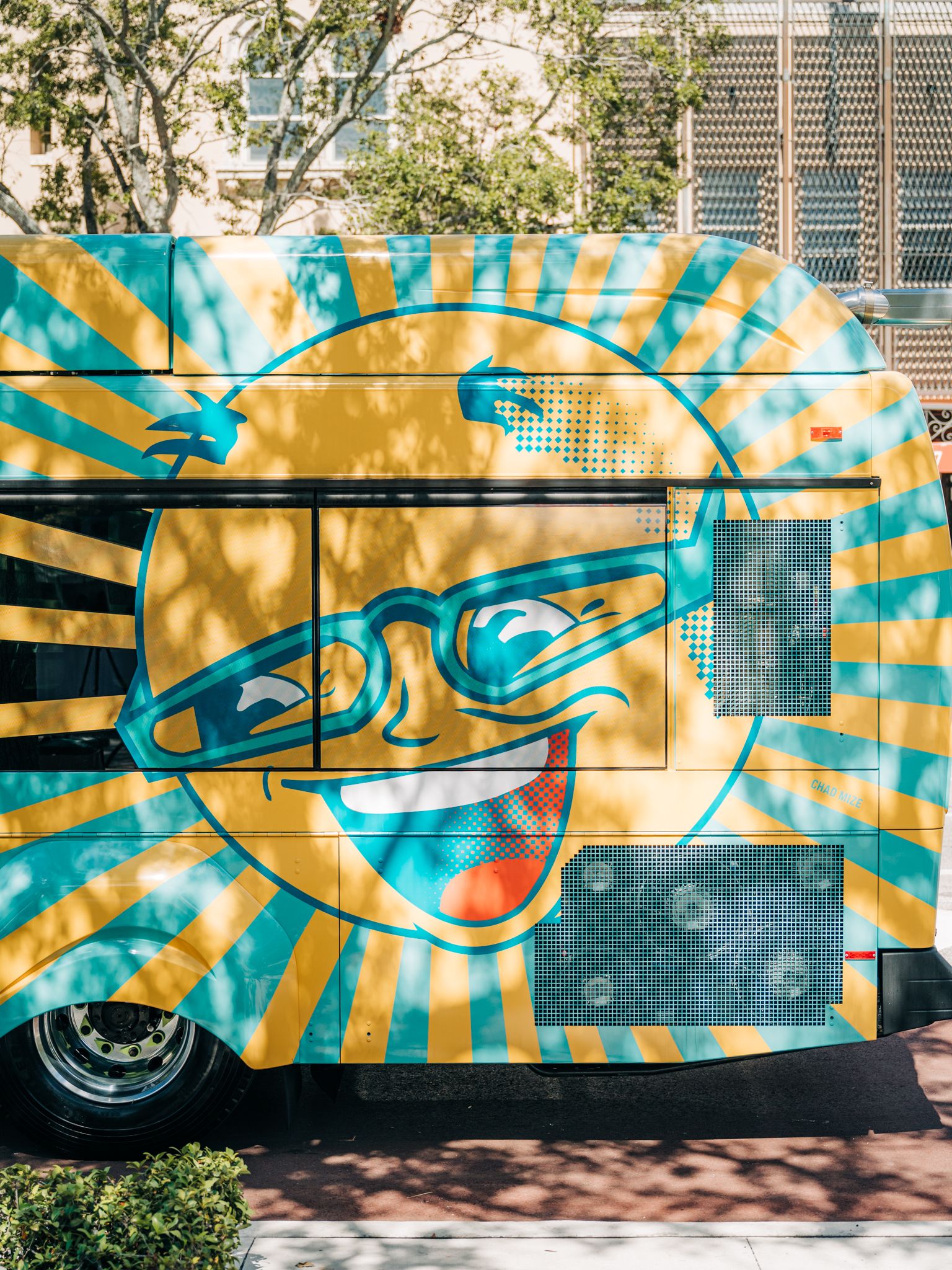
The Mr. Sun design on a SunRunner bus.
During the brand development of SunRunner, PSTA collaborated with local artist Chad Mize to create a bright, eye-catching design to make the new Bus Rapid Transit service stand out. Chad chose to pay homage to St. Petersburg’s iconic Mr. Sun mascot, created by photographer and artist Jack Swenningsen for Griffin Advertising in the 1940s. He had already created an incredible mural updating Mr. Sun in the alley behind 645 Central Avenue North in 2014, so he brought that design over to the SunRunner—it only made sense considering the name!
From there, PSTA’s Marketing department ran with the concept and developed a robust set of color swatches, assets, logos, bus wraps, and print and digital materials to introduce SunRunner to the public. Since the launch of the bus service, SunRunner’s branding has won national awards and earned the envy of transit nerds and riders across the country.
Outreach
As Marketing begins advertising the new service and SS&T ensures operators are trained, the Outreach team begins their plan to educate the public about the benefits of the service and how to use it. They start by learning how the service will work, if it will affect or connect with other routes, and what areas and demographics it will serve.
With this information, Outreach can develop a strategic plan of locations and communities to reach out to. Such efforts might include tabling at events or terminals, riding specific routes to speak with riders, or providing presentations to civic organizations, including Rotary clubs, Kiwanis clubs, HOAs, local chambers of commerce, and public information officers at various municipalities.

PSTA outreach set up with maps at Grand Central Station.
From there, the team works backward from the launch date to determine the phases of outreach necessary. At minimum, they will begin two weeks before launch and focus heavily on the week of the launch. For larger changes, they might start a month in advance. In the case of PSTA’s recent system redesign, the Connected Community Bus Network, outreach began two years beforehand. As the new network details were finalized this past year, outreach began in earnest in the spring, and then intensified 6 weeks leading up to launch day, including a week after to ensure people had the information they needed.
Outreach is a vital part of PSTA’s efforts to inform the public, as not all riders have access to social media or ride often enough to see print signage. The team is specially trained to communicate with folks of all walks of life and is armed with resources to help riders learn about other PSTA services and programs.
Media and Event Planning
Finally, the service is ready to be officially launched! And PSTA is known for putting out new services with an exciting launch event. These launch events are a chance for PSTA staff, community supporters, and stakeholders to celebrate the culmination of years of planning and hundreds of hours of work, and drum up excitement for folks to try out the new service.
Leading up to the launch, the Communications wing of the Marketing department will develop a media and event strategy. A location is chosen and coordinated with the Facilities team to ensure any materials are brought onsite and set up, such as tents, tables, chairs, easels, and a lectern for leaders or officials speaking at the event. Next, members of the Marketing and Facilities teams will conduct an on-site walk-through and map out where items will be placed. If any buses are needed for the event, Marketing will coordinate with the Operations team to arrange a vehicle to be present for the launch.
Launch events often include other fun elements such as confetti canons, live music, food or dessert trucks, and, most importantly, a ceremonial ribbon-cutting. It’s a great way to symbolize the start of the new service, especially when the bus itself cuts the ribbon like our SunRunner and Spark launches.
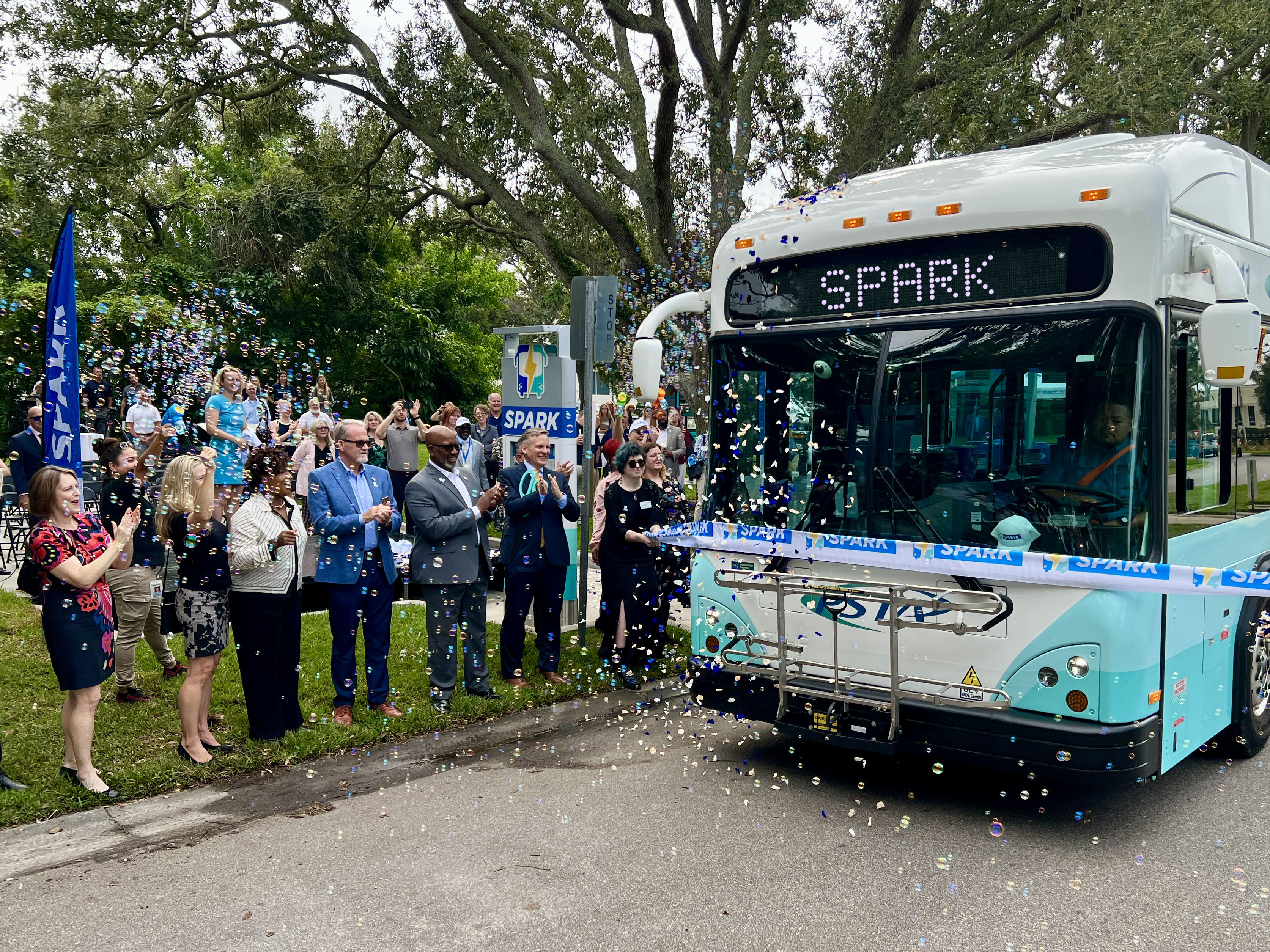
A Spark bus drives through a Spark ribbon to cut it.
Weeks before launch day, Marketing designs and orders branded promotional items to be given out at the event as keepsakes. For example, some of Spark’s launch event promo items included water bottles stylized like an electrifying energy drink, light-up frisbees featuring Spark’s lightning bug mascot “Sparky,” locally made candles and branded matchboxes, and stylish sunglasses to tame the Florida sunshine.
Some service launches will feature ridealongs for attendees, giving them an opportunity to experience the service firsthand—both SunRunner and Spark launches have featured these ridealongs.
Two days before the event, media advisories are sent out to traditional media outlets. Inviting media to these events is an important component of the agency’s overall marketing and outreach efforts, as it broadcasts the service’s features to millions of viewers across the county. Even in our digital world, many still rely on traditional media to get their news!
News media and social media efforts continue long after launch to advertise the new service and keep the momentum rolling along. And you can count on PSTA to always celebrate milestones like the one-millionth rider and each anniversary since launch!
Always Something New
The process detailed here and in part one is the result of four decades of experience launching new services in Pinellas County and learning from other transit agencies across the nation. Each new transit project is the result of the blood, sweat, and tears of countless hard-working transit professionals and supporters who are committed to providing new transportation options to their community.
And more services are coming down the pipeline! PSTA is currently hard at work relaunching the ferry service between St. Petersburg and Tampa. The agency is also looking at a potential transit option along the Alternate 19 corridor. And not to mention the new Clearwater Station, soon to begin construction! As you can see, PSTA is always looking ahead to launch new services and keep the wheels of public transit in the Tampa Bay Area rolling.
We’ll catch you at the next launch event for a new PSTA service!


